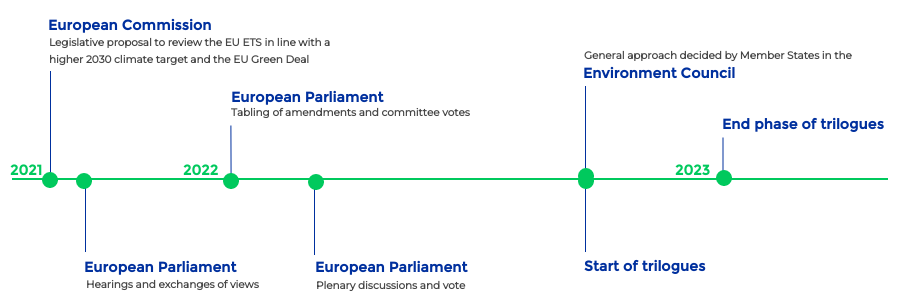ETX Module: Ongoing EU ETS Revision
Policy context
The launch of the European Green Deal and the commitment to achieving a 55% reduction in emissions by 2030, have led to the revision of key climate and energy legislation in the EU.
One of the key EU climate policies, the reform of the EU ETS is one of the essential elements for the successful implementation of the EU Green Deal and the achievement of the 2030 climate target. Its revision is part of a large legislative package launched in July 2021 containing reforms of existing legislation as well as new policies.
Regulating around 40% of European emissions, the EU ETS is a crucial piece of the legislative package. An ambitious reform of this directive can yield deep emissions reductions in energy-intensive industries, the power sector and aviation.
The Commission’s proposal for its reform, launched in July 2021, included some improvements to the current legislation as well as important new elements, such as the inclusion of maritime emissions and the implementation of a separate carbon market for road transport and buildings. However, this proposal fell short of overall ambition and the proper application of the “polluter-pays” principle.
Key moments in the EU ETS reform process

Commission Proposal in a nutshell

- Have a one-off reduction of the overall emissions cap of 117 million allowances (‘re-basing’), and a steeper annual emissions reduction of 4.2% (instead of 2.2% per year under the current system).
- Strengthen the Market Stability Reserve (MSR): Maintain the MSR intake rate of allowances at 24% (instead of reducing it to 12%) until 2030 and cancelling allowances held in reserve above 400 million.
- Lay the ground for a more stringent benchmark revision and establish conditionality for free allocation.
- Establish a new carbon border adjustment mechanism that will put a price on the carbon content of imports of a targeted selection of products to ensure that ambitious climate action in Europe does not lead to ‘carbon leakage’.
- Include Carbon Capture and Utilisation.

Extend emissions trading to new sectors by:
- Including emissions from maritime activities in the EU ETS.
- Introducing a new, separate emissions trading system to cover emissions from fuels used in road transport and buildings. To address the social impacts of the extension of emissions trading to road transport and buildings, the Commission has also presented a proposal for a Social Climate Fund.

- Spend the entirety of MS revenues from the auctioning of emissions allowances under the EU ETS for climate action and the transformation of the energy system, including measures to decarbonise the road transport and buildings sectors.
- Increase the size of the Innovation Fund and the Modernisation Fund.
European Parliament in a nutshell (June2022)

- Have a one-off reduction of the overall emissions cap done in two steps: 70 million allowances in 2024 and then 50 million allowances in 2026, and a progressively steeper annual emissions reduction rate: 4.4% in 2024, 4.5% in 2026 and 4.6% in 2029. The combination of the rebasings and the progressively increased LRF is meant to deliver a cut in ETS emissions of 64% compared to 2005 levels.
- Further strengthen the Market Stability Reserve (MSR): Maintain the MSR intake rate of allowances at 24% until 2030 and increase the quantity of allowances absorbed by the MSR (implementing more stringent thresholds).
- Implement more stringent benchmarks and establish further and stronger conditionality for free allocation.
- Support the creation of a new carbon border adjustment mechanism and widen the scope of this tool to cover more sectors and more emissions to ensure that ambitious climate action in Europe does not lead to ‘carbon leakage’.

Endorses the Commission’s proposal to extend emissions trading to new sectors by:
- Including emissions from maritime activities in the EU ETS.
- Introducing a new, separate emissions trading system to cover emissions from commercial fuels used in road transport and buildings from 2025. The new system will be extended to combustion in private road transport and private heating or cooling of residential buildings only from 1 January 2029.
- The Parliament added a large number of safeguards, including a price cap of 50 EUR and a limit for companies to shift the cost of pollution permits on to consumers and ensuring that all ETS2 revenues will be used to finance the Social Climate Fund which channels support to low-income households and vulnerable communities.

- Supports the Commission’s proposal to spend the entirety of member states revenues from the auctioning of emissions allowances under the EU ETS for climate action and the transformation of the energy system, including measures to decarbonise the road transport and buildings sectors.
- Slightly increases the size of the Innovation Fund while maintaining the proposed increase of the Modernisation Fund.
EU Environment Council position in a nutshell (June2022)

- Support the European Commission’s proposal to have a one-off reduction of the overall emissions cap of 117 million allowances (‘re-basing’), and a steeper annual emissions reduction of 4.2% (instead of 2.2% per year under the current system).
- Support Commission’s proposal to strengthen the Market Stability Reserve (MSR): Maintain the MSR intake rate of allowances at 24% until 2030 and increase the quantity of allowances absorbed by the MSR (implementing more stringent thresholds).
- Weaken the Commission’s proposal on the revision of ETS benchmarks by eliminating any form of conditionality for free allocation.
- Support the creation of a new carbon border adjustment mechanism but introduce a slower phase-in of the tool combined with an equivalent slower phase-out of free pollution permits.
- Include Carbon Capture and Utilisation.

Endorse the Commission’s proposal to extend emissions trading to new sectors by:
- Including emissions from maritime activities in the EU ETS.
- Introducing a new, separate emissions trading system to cover emissions from fuels used in road transport and buildings in 2027 (1 year later than the Commission’s proposal).
- Up to 59 billion EUR of the revenues generated from the new ETS can be used for the financing of the Social Climate Fund.

- Remove Commission’s proposal to mandate spending the entirety of member states revenues from the auctioning of emissions allowances under the EU ETS for climate action and the transformation of the energy system.
- Reduce the size of the Innovation Fund while maintaining the proposed increase of the Modernisation Fund.











